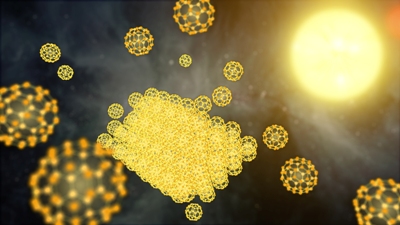Astronomers have found a solid form of buckyballs for the first time in space utilizing data obtained from NASA's Spitzer Space Telescope.
 NASA's Spitzer Space Telescope has detected the solid form of buckyballs in space for the first time. Credit: NASA/JPL-Caltech
NASA's Spitzer Space Telescope has detected the solid form of buckyballs in space for the first time. Credit: NASA/JPL-Caltech
Previous space studies by Spitzer had found the miniscule carbon spheres only in the form of gas. Buckyballs are named after their analogous to the geodesic domes of late architect Buckminster Fuller. The 60-carbon-molecule sphere’s formal name is buckminsterfullerene. The unique structure of buckyballs makes them suitable for chemical and electrical applications, including armor, water purification, medicines and superconducting materials.
In the latest space study using Spitzer, researchers discovered microscopic particles containing million of stacked buckyballs. They discovered the particles around ‘XX Ophiuchi,’ a pair of stars located at a 6,500-light-year distance from earth.
Nye Evans from Keele University informed that these buckyballs are collectively packed to create a solid. Evans is the lead author of an article appearing in the Royal Astronomical Society’s Monthly Notices.
The latest discovery of particles containing buckyballs confirms the presence of large amounts of these carbon molecules in some stellar conditions in order to bond and create solid particles. The researchers were able to detect the solid form of buckyballs using the Spitzer data as these molecules release light in an unusual way that varies from their gaseous form.
According to Mike Werner, who serves as Project Scientist for Spitzer at the Jet Propulsion Laboratory of NASA, the study findings suggest the widespread presence of buckyballs in space than the previous Spitzer results showed. On Earth, buckyballs exist in different forms.